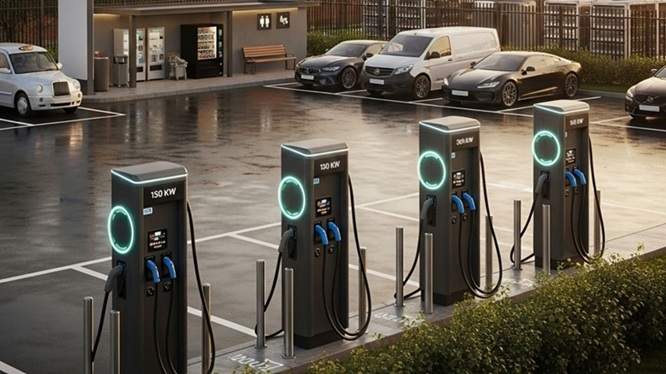When Tesla CEO abruptly disbanded the Supercharger team, it shook the EV world. Talent scattered. Questions popped up about the future of fast charging rollouts. Out of that upheaval, a new company has quietly sprung up with a focused mission: solve the “urban charging gap” for the vehicles that need it most.

Meet Hubber — a UK startup founded by three former members of Tesla’s Supercharger rollout team, Harry Fox, Connor Selwood and Hugh Leckie. These are the folks who helped oversee the deployment of roughly 100 Supercharger sites with some 1,200 chargers across the U.K. and Ireland. Now they’re taking that hard‑won experience and putting it squarely where cities are struggling: providing fast, reliable charging for taxis, ride‑hail drivers and last‑mile delivery vans.
Charging a family EV in suburbia is one thing. You park in a driveway, plug in overnight, and you’re good to go. Cities are another story. Many urban residents don’t have garages or private parking. Street chargers exist, but coverage and speed vary. And then there are the commercial drivers who put serious miles on their vehicles: taxis, couriers and ride‑hailing fleets. Hubber points out that these drivers charge roughly five times more often than private owners. That frequency creates a real need for high‑throughput charging capacity in central locations.
“Urban charging has unique demands,” Hubber says in its company filings. “Commercial vehicles need speed and affordability, not necessarily valet-style amenities.” So instead of building glossy plazas aimed at weekend shoppers, Hubber is aiming for practical hubs: high‑power chargers, efficient site layouts, and quick in‑and‑out access for drivers on the clock.
Hubber’s playbook is refreshingly pragmatic. The company hunts for sites that others might pass over — disused warehouses, old gas stations, tight urban lots — and converts them into charger‑ready hubs. The idea is to maximize throughput: light‑duty bays up front, larger bays set aside for box vans and delivery trucks, and dedicated space for transformers, battery storage and grid connections.
The hubs can include basic amenities — restrooms, vending, a sheltered rest area — but the priority is throughput. Hubber wants drivers back on the road quickly. For taxi and last‑mile operators, a site that’s slightly off the main drag but reliably fast and affordable is often a superior option to a premium plaza that’s crowded and costly.
Real experience behind the plan
What gives Hubber early credibility is the team’s background. Fox, Selwood and Leckie didn’t just work on chargers — they led complex infrastructure rollouts, handled grid connections, and learned the messy logistics of scaling EV infrastructure in dense urban environments. They say they are building the kind of sites they wished existed when scouting locations at their previous jobs.
Runway matters too: Hubber recently secured £60 million (roughly $81 million) in funding, a sizable boost that will help open its first sites and accelerate development. The company plans to scale beyond the U.K. and Ireland in time, but for now it’s focusing on establishing a strong local foundation.
Hubber’s debut location is about to go live in Forest Hill, South London, near Forest Hill Station. The initial hub will have 12 charging bays, featuring three 150 kW chargers and three 300 kW dual‑head units — configurations designed to serve both small EVs and heftier commercial vehicles. RAW Charging will operate the facility and is offering free fast charging during the first week to introduce drivers to the site.
It’s a modest footprint, but it’s deliberately built for high utilization rather than headline glamour. The model is simple: buy smarter urban sites, build them out with robust grid solutions and chargers that can serve a variety of vehicles, and operate them with a commercial focus.
Hubber isn’t just thinking about today’s taxi fleets. The company is mapping a potential path to a driverless future, where autonomous ride‑hail vehicles will have predictable, high‑volume charging needs. That future may require attendants or specialized equipment in the near term — robotic charging infrastructure for unattended vehicles is still an emerging technology — but Hubber says its sites will be adaptable to future charging workflows.
A silver lining from a chaotic moment
There’s a clear industry iron‑law at work: disruptive moves can redistribute top talent. Tesla’s decision to dissolve its Supercharger team created chaos at the time and drew criticism. But it also dispersed expertise across the market — and in this case, gave rise to a startup that’s laser‑focused on a real pain point.
For cities racing to decarbonize transport, focusing on the vehicles that drive the most miles makes a lot of sense. Household chargers remain essential, but electrifying urban fleets requires a different playbook: high throughput, smart site selection and cost‑effective operations. Hubber’s founders believe they know how to deliver that combination.
Even if you’re not a taxi driver, Hubber’s work could benefit you. Better urban charging for commercial fleets means fewer ICE delivery vehicles clogging city streets, and faster, more reliable electric taxis and couriers. That can translate into cleaner air and quieter neighborhoods — and, eventually, a charging network that works for everyone.
It’s early days for Hubber, and the proof will be in utilization rates, uptime and whether fleet operators actually switch over. But the recipe — experienced people, focused mission, pragmatic site choices and solid funding — gives the company a shot at making the kind of urban charging infrastructure cities desperately need. If it works, Hubber could be a model for how cities power their busiest vehicles without waiting for the next shiny charging plaza to pop up downtown.
Related Post
